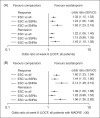Escitalopram--translating molecular properties into clinical benefit: reviewing the evidence in major depression
- PMID: 20147575
- PMCID: PMC2923415
- DOI: 10.1177/0269881109349835
Escitalopram--translating molecular properties into clinical benefit: reviewing the evidence in major depression
Abstract
The majority of currently marketed drugs contain a mixture of enantiomers; however, recent evidence suggests that individual enantiomers can have pharmacological properties that differ importantly from enantiomer mixtures. Escitalopram, the S-enantiomer of citalopram, displays markedly different pharmacological activity to the R-enantiomer. This review aims to evaluate whether these differences confer any significant clinical advantage for escitalopram over either citalopram or other frequently used antidepressants. Searches were conducted using PubMed and EMBASE (up to January 2009). Abstracts of the retrieved studies were reviewed independently by both authors for inclusion. Only those studies relating to depression or major depressive disorder were included. The search identified over 250 citations, of which 21 studies and 18 pooled or meta-analyses studies were deemed suitable for inclusion. These studies reveal that escitalopram has some efficacy advantage over citalopram and paroxetine, but no consistent advantage over other selective serotonin reuptake inhibitors. Escitalopram has at least comparable efficacy to available serotonin-norepinephrine reuptake inhibitors, venlafaxine XR and duloxetine, and may offer some tolerability advantages over these agents. This review suggests that the mechanistic advantages of escitalopram over citalopram translate into clinical efficacy advantages. Escitalopram may have a favourable benefit-risk ratio compared with citalopram and possibly with several other antidepressant agents.
Figures

Similar articles
-
Escitalopram versus citalopram: the surprising role of the R-enantiomer.Psychopharmacology (Berl). 2004 Jul;174(2):163-76. doi: 10.1007/s00213-004-1865-z. Psychopharmacology (Berl). 2004. PMID: 15160261 Review.
-
Efficacy of escitalopram in the treatment of major depressive disorder compared with conventional selective serotonin reuptake inhibitors and venlafaxine XR: a meta-analysis.J Psychiatry Neurosci. 2006 Mar;31(2):122-31. J Psychiatry Neurosci. 2006. PMID: 16575428 Free PMC article.
-
Escitalopram.Drugs Today (Barc). 2004 Feb;40(2):121-31. doi: 10.1358/dot.2004.40.2.799424. Drugs Today (Barc). 2004. PMID: 15045034 Review.
-
[Escitalopram for treatment of major depressive disorder in adults].Encephale. 2005 Jul-Aug;31(4 Pt 1):490-501. doi: 10.1016/s0013-7006(05)82410-8. Encephale. 2005. PMID: 16389716 Review. French.
-
Escitalopram : a review of its use in the management of major depressive and anxiety disorders.CNS Drugs. 2003;17(5):343-62. doi: 10.2165/00023210-200317050-00004. CNS Drugs. 2003. PMID: 12665392 Review.
Cited by
-
Acute escitalopram treatment inhibits REM sleep rebound and activation of MCH-expressing neurons in the lateral hypothalamus after long term selective REM sleep deprivation.Psychopharmacology (Berl). 2013 Aug;228(3):439-49. doi: 10.1007/s00213-013-3046-4. Epub 2013 Mar 21. Psychopharmacology (Berl). 2013. PMID: 23515582
-
Citalopram versus other anti-depressive agents for depression.Cochrane Database Syst Rev. 2012 Jul 11;2012(7):CD006534. doi: 10.1002/14651858.CD006534.pub2. Cochrane Database Syst Rev. 2012. PMID: 22786497 Free PMC article.
-
Escitalopram, an antidepressant with an allosteric effect at the serotonin transporter--a review of current understanding of its mechanism of action.Psychopharmacology (Berl). 2012 Jan;219(1):1-13. doi: 10.1007/s00213-011-2463-5. Epub 2011 Sep 8. Psychopharmacology (Berl). 2012. PMID: 21901317 Review.
-
Impact of antidepressants on cytokine production of depressed patients in vitro.Toxins (Basel). 2013 Nov 19;5(11):2227-40. doi: 10.3390/toxins5112227. Toxins (Basel). 2013. PMID: 24257035 Free PMC article.
References
-
- Anders M, Tuma I, Rösslerova H. (2008) A surveillance study of escitalopram treatment of depressed patients. Expert OpinPharmaco 9: 1–6 - PubMed
-
- Ariens EJ, Soudijn W, Timmermans PBHWH. (1983) Stereochemistry and Biological Activity of Drugs. Oxford: Blackwell
-
- Baldwin DS, Cooper JA, Huusom AK, Hindmarch I. (2006) A double-blind, randomized, parallel-group, flexible-dose study to evaluate the tolerability, efficacy and effects of treatment discontinuation with escitalopram and paroxetine in patients with major depressive disorder. Int Clin Psychopharm 21: 159–169 - PubMed
-
- Baldwin DS, Reines EH, Guiton C, Weiller E. (2007) Escitalopram therapy for major depression and anxiety disorders. Ann Pharmacother 41: 1583–1592 - PubMed
-
- Baumann P, Zullino DF, Eap CB. (2002) Enantiomers' potential in psychopharmacology - a critical analysis with special emphasis on the antidepressant escitalopram. Eur Neuropsychopharm 12: 433–444 - PubMed
Publication types
MeSH terms
Substances
LinkOut - more resources
Full Text Sources

